SARDI researchers take ocean ride with endangered seals through 'sea lion cam'
ABC Eyre Peninsula / By Jodie Hamilton
Australian sea lions are taking scientists underwater for the first time thanks to cameras attached to their backs, leaving researchers stunned by the "absolutely astounding" footage.
Key points:
Cameras were fitted to six endangered Australian sea lions in South Australian waters
The video footage revealed diverse feeding grounds, from coral reefs to sandy bottoms and kelp grounds
It also provided evidence that the species uses social learning to pass on foraging techniques to pups
A sea lion, or Neophoca cinerea, was filmed nipping the tail of a bronze whaler shark and swimming through dolphins feeding on baitfish, while the first evidence of mothers teaching their pups to hunt and forage for food was also captured.
South Australian Research and Development Institute (SARDI) Marine Ecosystems lead Professor Simon Goldsworthy said watching the "sea lion cam" footage was like being "right there with the animal".
"You're kind of getting a joy ride on the back of a sea lion, so it's a bit of a rollercoaster sometimes," he said.
"They're zooming very close to the seabed, gliding over the surface.
"There's little canyons and caves that the animals are zooming in and out of."
A sea lion swims through dolphins feeding on a school of bait fish.
(Supplied: SARDI/NESP Marine and Coastal Hub)
Australian sea lions are the rarest seal species in the country's waters, with 82 per cent of the population found off SA and 18 per cent off Western Australia.
Their numbers have declined by about 60 per cent over the past 40 years — decimated by sealers and shark fishery gillnets in the past and now facing threats of marine debris, pollution and disease.
Cameras glued to fur
Six sea lions on two South Australian islands were fitted with cameras to record 12 hours of their life at sea, diving and foraging for food.
The sea lions were sedated while the camera was glued onto their fur, and then sedated again so it could be retrieved when a satellite tracker showed the animal had returned to land three to four days later.
"It's a pretty quick process. We position the camera just behind the shoulders," Professor Goldsworthy said.
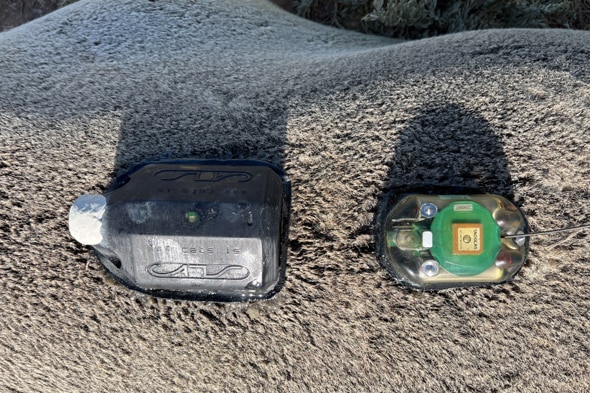
Australian sea lions are the rarest seal species in the country's waters, with 82 per cent of the population found off SA and 18 per cent off Western Australia.
Their numbers have declined by about 60 per cent over the past 40 years — decimated by sealers and shark fishery gillnets in the past and now facing threats of marine debris, pollution and disease.
Cameras glued to fur
Six sea lions on two South Australian islands were fitted with cameras to record 12 hours of their life at sea, diving and foraging for food.
The sea lions were sedated while the camera was glued onto their fur, and then sedated again so it could be retrieved when a satellite tracker showed the animal had returned to land three to four days later.
"It's a pretty quick process. We position the camera just behind the shoulders," Professor Goldsworthy said.
The camera [L] and GPS tag are glued onto the fur of a female Australian sea lion.(Supplied: Simon Goldsworthy, SARDI)
He said satellite tags had been used on sea lions for 20 years, so researchers knew some fed close to their colonies while others spent days at sea swimming out to areas of the continental shelf.
But they knew little of the types of habitats critical for the sea lion's survival until the camera project began with two animals at Olive Island near Streaky Bay on Eyre Peninsula in December last year.
Four more were attached with cameras off Seal Bay at Kangaroo Island earlier this year.
"When you're travelling over wafting kelp you really feel like you're right there with the animal," Professor Goldsworthy said.
"Some of the footage we've been getting while they're down there has been absolutely astounding."
Diverse habitats revealed
Professor Goldsworthy said the project had revealed diverse habitats, from animals feeding in algal reefs or seagrass meadows, to deeper high reefs covered in sponges and other invertebrates, to animals feeding on bare sand.
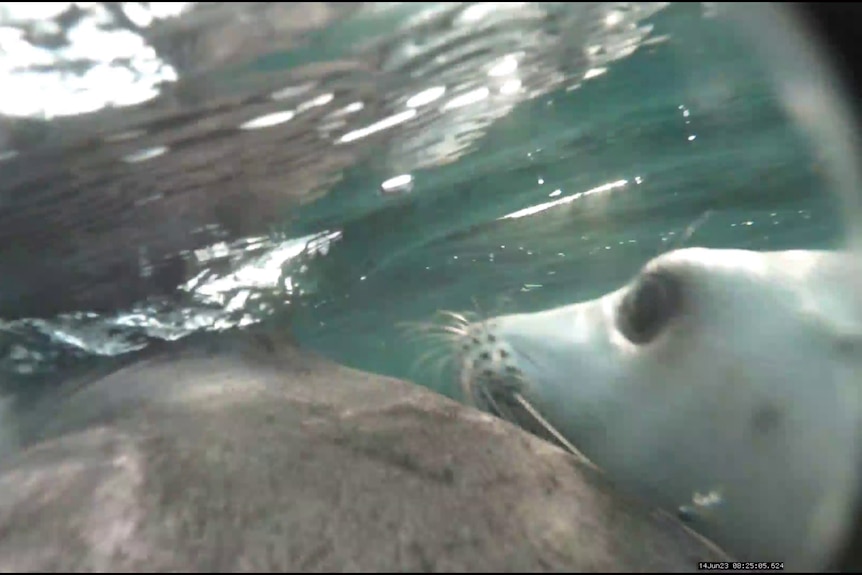
He said satellite tags had been used on sea lions for 20 years, so researchers knew some fed close to their colonies while others spent days at sea swimming out to areas of the continental shelf.
But they knew little of the types of habitats critical for the sea lion's survival until the camera project began with two animals at Olive Island near Streaky Bay on Eyre Peninsula in December last year.
Four more were attached with cameras off Seal Bay at Kangaroo Island earlier this year.
"When you're travelling over wafting kelp you really feel like you're right there with the animal," Professor Goldsworthy said.
"Some of the footage we've been getting while they're down there has been absolutely astounding."
Diverse habitats revealed
Professor Goldsworthy said the project had revealed diverse habitats, from animals feeding in algal reefs or seagrass meadows, to deeper high reefs covered in sponges and other invertebrates, to animals feeding on bare sand.
A playful pup interacts with its mother on an eight-hour foraging trip.
(Supplied: SARDI/NESP Marine and Coastal Hub)
"[We've seen] animals feeding on little stingrays called stingarees, lots of cuttlefish, octopus, flathead, small sharks — you name it. They've got a pretty diverse diet," he said.
The project had also recorded evidence of a mother teaching her pup how to forage for food — a theory behind why their pups were nursed for 18 months.
"We've got amazing footage of a mother and pup exploring under ledges and probing under rocks to find food and one amazing bit of footage where the mother grabs a cuttlefish and the pup gets very excited and she brings that up to the surface where they consume it," Professor Goldsworthy said.
"So we now have clear evidence that there is a social component to pups learning where to go to hunt and what habitats to feed in, so it's really opened up our understanding of the amazing ecology of the species."
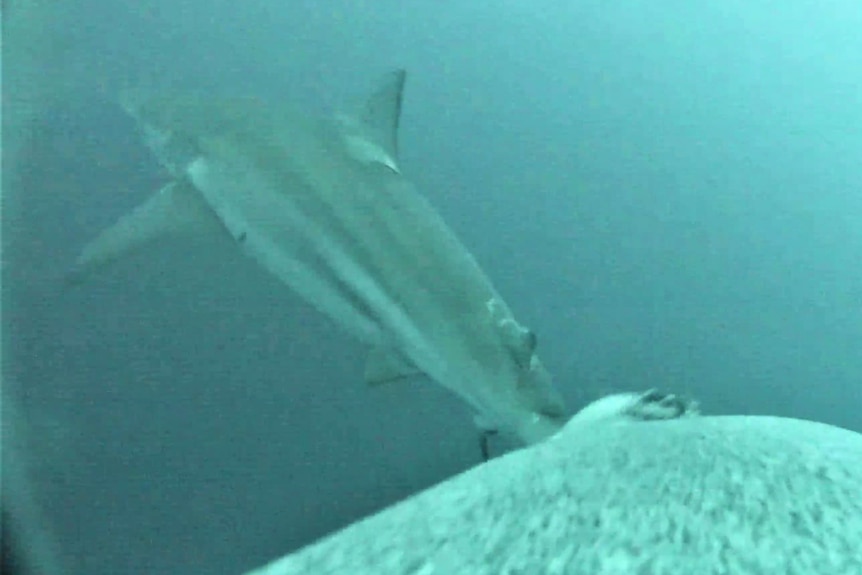
"[We've seen] animals feeding on little stingrays called stingarees, lots of cuttlefish, octopus, flathead, small sharks — you name it. They've got a pretty diverse diet," he said.
The project had also recorded evidence of a mother teaching her pup how to forage for food — a theory behind why their pups were nursed for 18 months.
"We've got amazing footage of a mother and pup exploring under ledges and probing under rocks to find food and one amazing bit of footage where the mother grabs a cuttlefish and the pup gets very excited and she brings that up to the surface where they consume it," Professor Goldsworthy said.
"So we now have clear evidence that there is a social component to pups learning where to go to hunt and what habitats to feed in, so it's really opened up our understanding of the amazing ecology of the species."
A sea lion is captured giving this bronze whaler a bite on the tail.
(Supplied: SARDI/NESP Marine and Coastal Hub)
Sea lion cam also documented encounters with other wildlife.
"One female cruised through a group of dolphins feeding in the water column and they had a big ball of sardines all balled up and the sea lion just cruises through and you get a great view of that," Professor Goldsworthy said.
"There's some interesting encounters with sharks where the sea lion gave a big bronze whaler a nip on the tail."
Improving technology
The camera switches on at a certain depth and a computer records depth profile and position using a gimbaled compass, recording the animal's speed and whether it is going up or down or left or right.
"The combination of all these instruments, we get phenomenal detail on what the animal's doing while they're down there," Professor Goldsworthy said.
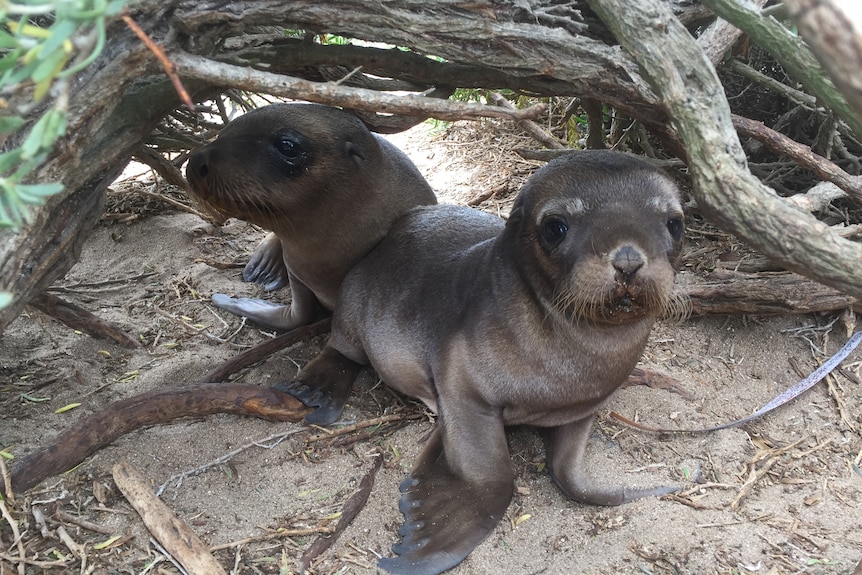
Sea lion cam also documented encounters with other wildlife.
"One female cruised through a group of dolphins feeding in the water column and they had a big ball of sardines all balled up and the sea lion just cruises through and you get a great view of that," Professor Goldsworthy said.
"There's some interesting encounters with sharks where the sea lion gave a big bronze whaler a nip on the tail."
Improving technology
The camera switches on at a certain depth and a computer records depth profile and position using a gimbaled compass, recording the animal's speed and whether it is going up or down or left or right.
"The combination of all these instruments, we get phenomenal detail on what the animal's doing while they're down there," Professor Goldsworthy said.
Australian sea lion pups photographed at Langton Island in SA's Spencer Gulf.(Supplied: Simon Goldsworthy, SARDI)
He said large cumbersome and unsuitable video cameras had been tried before with varying level of success but the new technology was far superior.
"You're … sitting on the back of the animal, getting an animal's perspective as it travels across the sea floor," Professor Goldsworthy said.
"[It records for] 12 hours where we might have several hundred dives.
"It's the best live TV you could watch. It's very entertaining."
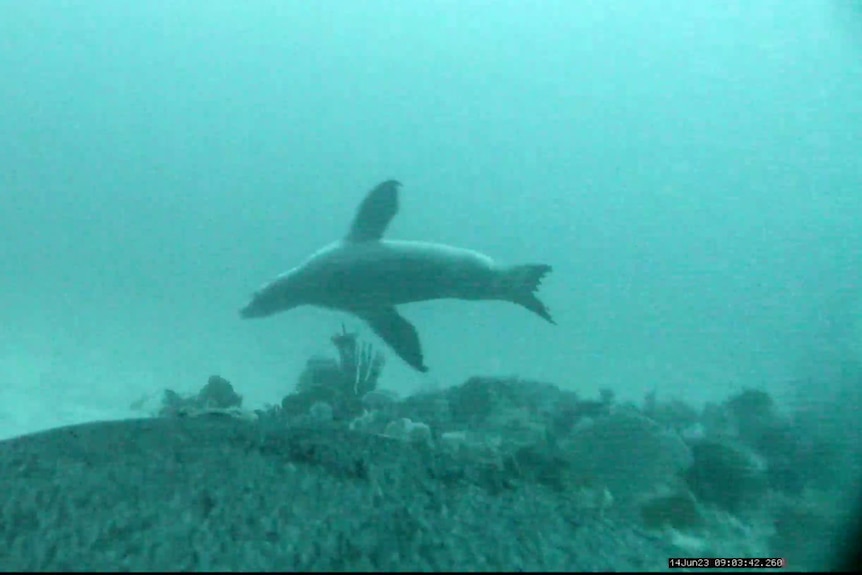 A mother's view of her pup swimming over a low reef covered in sponges looking for food.(Supplied: SARDI/NESP Marine Coastal Hub)
A mother's view of her pup swimming over a low reef covered in sponges looking for food.(Supplied: SARDI/NESP Marine Coastal Hub)
Marathon feeding trips
Professor Goldsworthy said the sea lions were at sea for three or four days at a time, during which time they did not sleep and "every dive they're trying to nail fish or squid and cuttlefish".
"It would be like you or I running in an ultra-marathon for two or three days with no sleep and having to eat a banana every minute or two while you're doing it," he said.
"Their capacity to work and consume is just astounding and it's no wonder when they return to the breeding colonies where they nurse their pups they just absolutely flake out on the rocks."
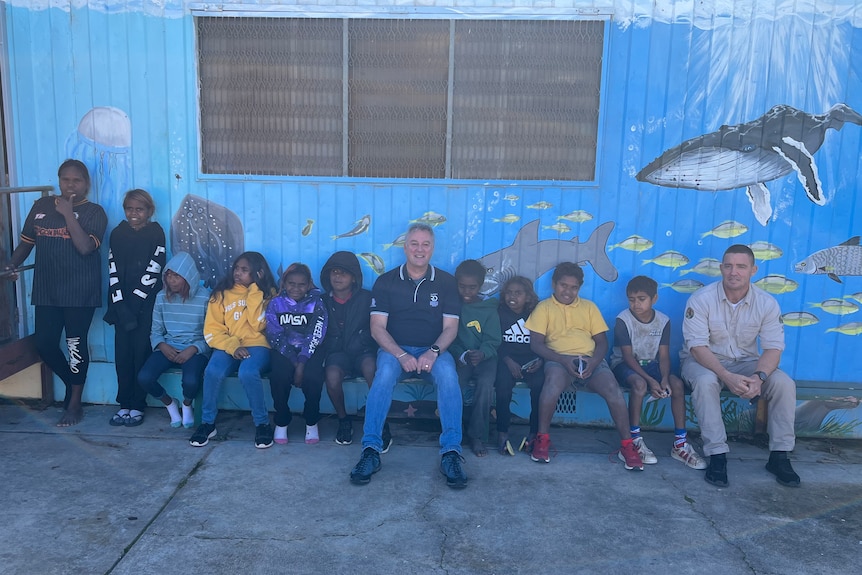 Professor Goldsworthy [C] and Western Eyre Marine Park manager Dirk Holman with Yalata students.(Supplied)
Professor Goldsworthy [C] and Western Eyre Marine Park manager Dirk Holman with Yalata students.(Supplied)
Data has shown the species is still in decline, numbering between 15,000 and 10,000 on islands and at the bottom of the Great Australian Bight cliffs.
Its recovery has been hampered by an 18-month breeding cycle as opposed to the 12-month cycle of all other seal species.
The National Environmental Science Program-funded project is a collaboration between SARDI, the SA Department for Environment and Water, the University of Adelaide, and the Far West Coast Aboriginal Corporation.
The project was showcased with students at Ceduna and Yalata schools as part of NAIDOC celebrations last week.
Sea lions feature in cultural songlines for the Wirangu and Mirning people.
He said large cumbersome and unsuitable video cameras had been tried before with varying level of success but the new technology was far superior.
"You're … sitting on the back of the animal, getting an animal's perspective as it travels across the sea floor," Professor Goldsworthy said.
"[It records for] 12 hours where we might have several hundred dives.
"It's the best live TV you could watch. It's very entertaining."
Marathon feeding trips
Professor Goldsworthy said the sea lions were at sea for three or four days at a time, during which time they did not sleep and "every dive they're trying to nail fish or squid and cuttlefish".
"It would be like you or I running in an ultra-marathon for two or three days with no sleep and having to eat a banana every minute or two while you're doing it," he said.
"Their capacity to work and consume is just astounding and it's no wonder when they return to the breeding colonies where they nurse their pups they just absolutely flake out on the rocks."
Data has shown the species is still in decline, numbering between 15,000 and 10,000 on islands and at the bottom of the Great Australian Bight cliffs.
Its recovery has been hampered by an 18-month breeding cycle as opposed to the 12-month cycle of all other seal species.
The National Environmental Science Program-funded project is a collaboration between SARDI, the SA Department for Environment and Water, the University of Adelaide, and the Far West Coast Aboriginal Corporation.
The project was showcased with students at Ceduna and Yalata schools as part of NAIDOC celebrations last week.
Sea lions feature in cultural songlines for the Wirangu and Mirning people.
No comments:
Post a Comment